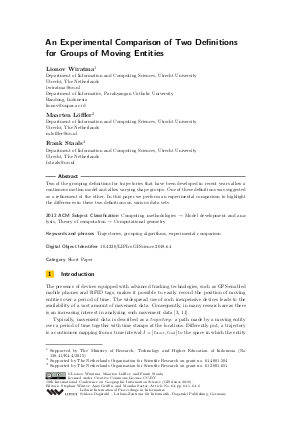An Experimental Comparison of Two Definitions for Groups of Moving Entities (Short Paper)
Authors Lionov Wiratma, Maarten Löffler, Frank Staals
-
Part of:
Volume:
10th International Conference on Geographic Information Science (GIScience 2018)
Part of: Series: Leibniz International Proceedings in Informatics (LIPIcs)
Part of: Conference: International Conference on Geographic Information Science (GIScience) - License:
 Creative Commons Attribution 3.0 Unported license
Creative Commons Attribution 3.0 Unported license
- Publication Date: 2018-08-02
File

PDF
LIPIcs.GISCIENCE.2018.64.pdf
- Filesize: 472 kB
- 6 pages
Document Identifiers
Subject Classification
ACM Subject Classification
- Computing methodologies → Model development and analysis
- Theory of computation → Computational geometry
Keywords
- Trajectories
- grouping algorithms
- experimental comparison
Metrics
- Access Statistics
-
Total Accesses (updated on a weekly basis)
0Document
0Metadata
Abstract
Two of the grouping definitions for trajectories that have been developed in recent years allow a continuous motion model and allow varying shape groups. One of these definitions was suggested as a refinement of the other. In this paper we perform an experimental comparison to highlight the differences in these two definitions on various data sets.
Cite As Get BibTex
Lionov Wiratma, Maarten Löffler, and Frank Staals. An Experimental Comparison of Two Definitions for Groups of Moving Entities (Short Paper). In 10th International Conference on Geographic Information Science (GIScience 2018). Leibniz International Proceedings in Informatics (LIPIcs), Volume 114, pp. 64:1-64:6, Schloss Dagstuhl – Leibniz-Zentrum für Informatik (2018)
https://doi.org/10.4230/LIPIcs.GISCIENCE.2018.64
BibTex
@InProceedings{wiratma_et_al:LIPIcs.GISCIENCE.2018.64,
author = {Wiratma, Lionov and L\"{o}ffler, Maarten and Staals, Frank},
title = {{An Experimental Comparison of Two Definitions for Groups of Moving Entities}},
booktitle = {10th International Conference on Geographic Information Science (GIScience 2018)},
pages = {64:1--64:6},
series = {Leibniz International Proceedings in Informatics (LIPIcs)},
ISBN = {978-3-95977-083-5},
ISSN = {1868-8969},
year = {2018},
volume = {114},
editor = {Winter, Stephan and Griffin, Amy and Sester, Monika},
publisher = {Schloss Dagstuhl -- Leibniz-Zentrum f{\"u}r Informatik},
address = {Dagstuhl, Germany},
URL = {https://drops.dagstuhl.de/entities/document/10.4230/LIPIcs.GISCIENCE.2018.64},
URN = {urn:nbn:de:0030-drops-93928},
doi = {10.4230/LIPIcs.GISCIENCE.2018.64},
annote = {Keywords: Trajectories, grouping algorithms, experimental comparison}
}
Author Details
- Department of Information and Computing Sciences, Utrecht University, Utrecht, The Netherlands, mailto:l.wiratma@uu.nl, Department of Informatics, Parahyangan Catholic University, Bandung, Indonesia
- Department of Information and Computing Sciences, Utrecht University, Utrecht, The Netherlands
Funding
- Wiratma, Lionov: Supported by The Ministry of Research, Technology and Higher Education of Indonesia (No. 138.41/E4.4/2015)
- Löffler, Maarten: Supported by The Netherlands Organisation for Scientfic Research on grant no. 614.001.504
- Staals, Frank: Supported by The Netherlands Organisation for Scientfic Research on grant no. 612.001.651
References
-
Marc Benkert, Joachim Gudmundsson, Florian Hübner, and Thomas Wolle. Reporting flock patterns. Comput. Geom., 41(3):111-125, 2008.

-
Kevin Buchin, Maike Buchin, Marc van Kreveld, Bettina Speckmann, and Frank Staals. Trajectory grouping structure. Journal of Computational Geometry, 6(1):75-98, 2015.

-
Joachim Gudmundsson, Patrick Laube, and Thomas Wolle. Computational movement analysis. In Wolfgang Kresse and David N. Danko, editors, Handbook of Geographic Information, pages 725-741. Springer, Berlin, 2012.

-
Stefan Holl. Methoden für die Bemessung der Leistungsfähigkeit multidirektional genutzter Fußverkehrsanlagen. Dr., Bergische Universität Wuppertal, Jülich, 2016. Bergische Universität Wuppertal, Diss., 2016.

-
Yan Huang, Cai Chen, and Pinliang Dong. Modeling Herds and Their Evolvements from Trajectory Data, pages 90-105. Springer, Berlin, 2008.

-
San-Yih Hwang, Ying-Han Liu, Jeng-Kuen Chiu, and Ee-Peng Lim. Mining mobile group patterns: A trajectory-based approach. In Proc. 9th Pacific-Asia Conference on Advances in Knowledge Discovery and Data Mining, PAKDD'05, pages 713-718. Springer, 2005.

-
Hoyoung Jeung, Man Lung Yiu, Xiaofang Zhou, Christian S. Jensen, and Heng Tao Shen. Discovery of convoys in trajectory databases. PVLDB, 1(1):1068-1080, 2008.

-
Panos Kalnis, Nikos Mamoulis, and Spiridon Bakiras. On Discovering Moving Clusters in Spatio-temporal Data, pages 364-381. Springer, Berlin, 2005.

-
Zhenhui Li, Bolin Ding, Jiawei Han, and Roland Kays. Swarm: Mining relaxed temporal moving object clusters. PVLDB, 3(1):723-734, 2010.

-
Marc van Kreveld, Maarten Löffler, Frank Staals, and Lionov Wiratma. A Refined Definition for Groups of Moving Entities and its Computation. In Proc. 27th International Symposium on Algorithms and Computation, volume 64, pages 48:1-48:12. LIPIcs, 2016.

-
Yu Zheng and Xiaofang Zhou. Computing with Spatial Trajectories. Springer, 2011.

